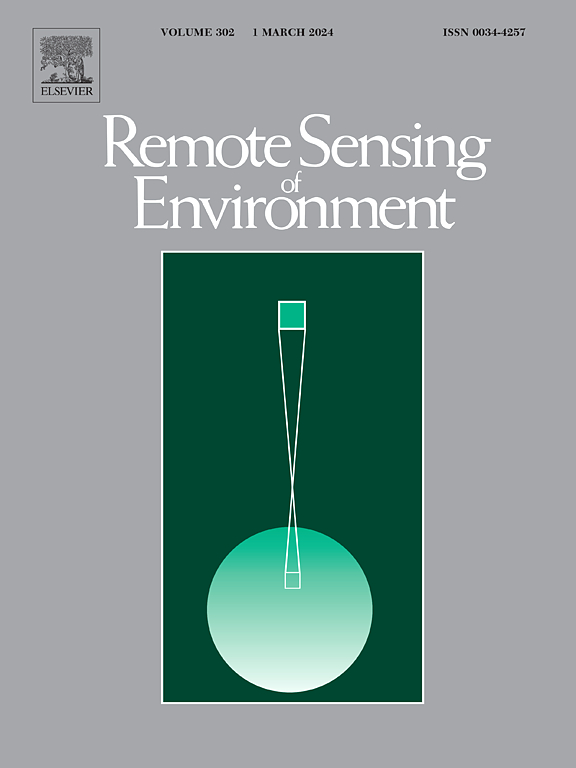Bias correction for near-real-time estimation of snow water equivalent using machine learning algorithms: A case study in the Tuolumne River basin, California
IF 11.1
1区 地球科学
Q1 ENVIRONMENTAL SCIENCES
引用次数: 0
Abstract
Accurately estimating snow water equivalent (SWE) in near-real-time is important for water resources management and water supply forecasting in snow-dominant regions. However, conventional SWE estimation approaches have large uncertainties in mountainous regions due to complex terrain, snow-vegetation interactions, and other challenging factors. This study develops a SWE bias correction framework (SWE-BCF) that utilizes the Airborne Snow Observatories (ASO) SWE data and machine learning (ML) algorithms to correct biases in a near-real-time SWE estimation linear regression model (LRM). The spatial distribution of LRM SWE residuals, which are estimated using the ASO SWE, is explicitly modeled using multiple ML algorithms and evaluated using a leave-one-out cross-validation (LOOCV) workflow. A wide range of commonly used ML algorithms is examined to model LRM SWE residuals, including Gaussian Process Regression (GPR), Support Vector Machine (SVM), Bayesian Regularized Neural Networks (BRNN), Random Forest (RF), and Gradient Boosting Machine (GBM). The results show that all ML algorithms substantially improve LRM SWE estimation accuracy. While the Kruskal-Wallis test indicates no significant difference (p-value >0.05) among the bias correction models, the RF model outperforms others, with the highest median R2 (0.89), the lowest median RMSE (69 mm), MAE (41 mm), and NRMSE (37.4 %), as well as the second-best median PBIAS (−6.6 %) in the LOOCV for correcting SWE bias. Four performance metrics (R2, MAE, RMSE, NRMSE) show significant improvements (p-value <0.05) over the original LRM model, highlighting the effectiveness of SWE-BCF in correcting the spatial patterns of SWE. However, the correction in the basin-wide average SWE, as indicated by the PBIAS values, exhibits high variance and does not show significant improvement (p-value >0.05). Among the three land cover types in the Upper Tuolumne River Basin, the alpine area showed the most substantial SWE improvements with the SWE-BCF. The structural adaptability of the SWE-BCF enables its transferability to various geographic locations and SWE datasets, allowing for an extension of coverage and frequency of more accurate SWE estimates. This potential advancement may improve water management decisions which rely on accurate water supply forecasts.
利用机器学习算法进行近实时雪水当量估算的偏差校正:以加利福尼亚州图奥勒米河流域为例
近实时准确估算雪水当量(SWE)对积雪优势区水资源管理和供水预报具有重要意义。然而,传统的SWE估计方法在山区由于复杂的地形、雪-植被相互作用和其他具有挑战性的因素而具有很大的不确定性。本研究开发了一个SWE偏差校正框架(SWE- bcf),该框架利用机载雪观测站(ASO) SWE数据和机器学习(ML)算法来校正近实时SWE估计线性回归模型(LRM)中的偏差。使用ASO SWE估计的LRM SWE残差的空间分布使用多个ML算法显式建模,并使用留一交叉验证(LOOCV)工作流进行评估。研究了广泛的常用ML算法来建模LRM SWE残差,包括高斯过程回归(GPR),支持向量机(SVM),贝叶斯正则化神经网络(BRNN),随机森林(RF)和梯度增强机(GBM)。结果表明,所有ML算法都显著提高了LRM SWE估计的精度。虽然Kruskal-Wallis检验显示各偏差校正模型之间没有显著差异(p值>;0.05),但RF模型优于其他模型,在校正SWE偏差的LOOCV中,R2中值最高(0.89),RMSE中值最低(69 mm), MAE中值最低(41 mm), NRMSE中值最低(37.4%),PBIAS中值次之(- 6.6%)。4个绩效指标(R2、MAE、RMSE、NRMSE)比原LRM模型有显著改善(p值<;0.05),突出了SWE- bcf在纠正SWE空间格局方面的有效性。然而,在全流域平均SWE的修正中,PBIAS值显示出高方差,没有显着改善(p值>;0.05)。在三种土地覆盖类型中,高寒地区SWE在SWE- bcf作用下的改善最为显著。SWE- bcf的结构适应性使其可转移到不同的地理位置和SWE数据集,从而可以扩展更准确的SWE估计的覆盖范围和频率。这一潜在的进步可能会改善依赖准确供水预测的水管理决策。
本文章由计算机程序翻译,如有差异,请以英文原文为准。
求助全文
约1分钟内获得全文
求助全文
来源期刊

Remote Sensing of Environment
环境科学-成像科学与照相技术
CiteScore
25.10
自引率
8.90%
发文量
455
审稿时长
53 days
期刊介绍:
Remote Sensing of Environment (RSE) serves the Earth observation community by disseminating results on the theory, science, applications, and technology that contribute to advancing the field of remote sensing. With a thoroughly interdisciplinary approach, RSE encompasses terrestrial, oceanic, and atmospheric sensing.
The journal emphasizes biophysical and quantitative approaches to remote sensing at local to global scales, covering a diverse range of applications and techniques.
RSE serves as a vital platform for the exchange of knowledge and advancements in the dynamic field of remote sensing.
 求助内容:
求助内容: 应助结果提醒方式:
应助结果提醒方式:


